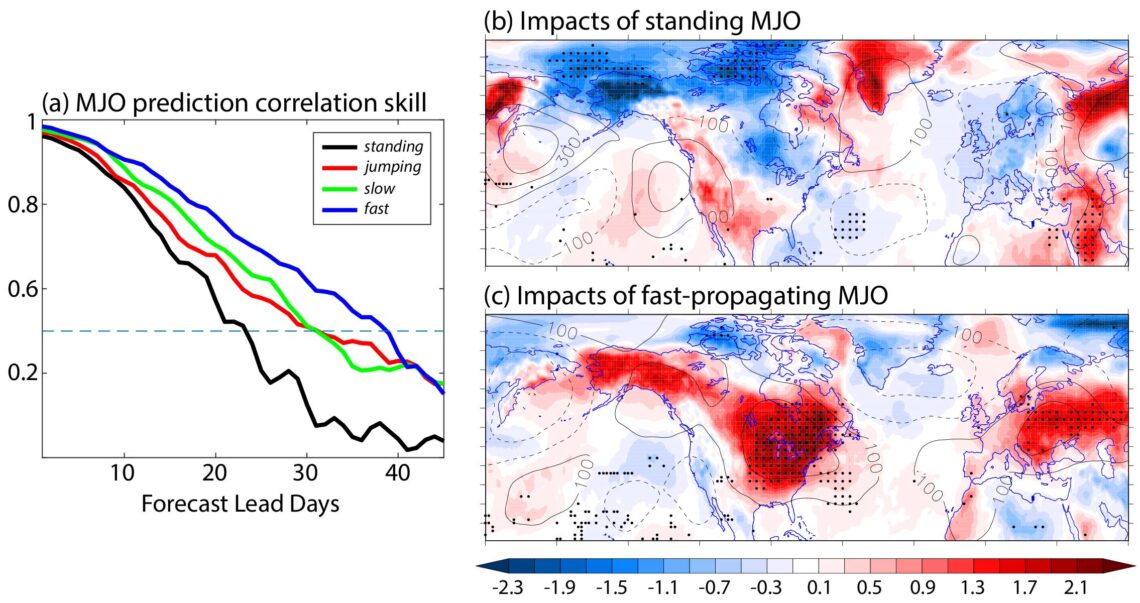April 5th, 2022
Key Findings
- GFDL has developed a new subseasonal prediction system using the GFDL Seamless System for Prediction and Earth-system Research (SPEAR), a global atmosphere-ocean-land-sea ice coupled climate model.
- Over 20 years of wintertime reforecasts with SPEAR, the average prediction skill of the Madden-Julian oscillation (MJO) was 30 days, placing it among the very best MJO prediction models in the world. Since MJO is the dominant subseasonal phenomenon over the tropics, its prediction is critical for subseasonal prediction of extreme events.
- This study showed that 4 distinct patterns of the MJO each have their own predictability, together with distinct teleconnection patterns. SPEAR is able to skillfully predict the “fast-propagating” form of MJO out to 38 days.
Baoqiang Xiang, Lucas Harris, Thomas L. Delworth, Bin Wang, Guosen Chen, Jan-Huey Chen, Spencer K. Clark, William F. Cooke, Kun Gao, J. Jacob Huff, Liwei Jia, Nathaniel C. Johnson, Sarah B. Kapnick, Feiyu Lu, Colleen McHugh, Yongqiang Sun, Mingjing Tong, Xiaosong Yang, Fanrong Zeng, Ming Zhao, Linjiong Zhou, Xiaqiong Zhou. Bulletin of the American Meteorology Society. DOI: 10.1175/BAMS-D-21-0124.1
Prediction on weather and seasonal timescales has become routine, but the “subseasonal” time scale of a few weeks has proven difficult. The Madden-Julian oscillation (MJO), a large complex of tropical thunderstorms, is the dominant subseasonal phenomenon over the tropics, and its prediction is critical for subseasonal prediction of tropical cyclones, atmospheric rivers, and other extreme events.
GFDL has developed a new subseasonal prediction system using the GFDL Seamless System for Prediction and Earth-system Research (SPEAR), a global atmosphere-ocean-land-sea ice coupled climate model. In 20 years of wintertime reforecasts, this study found that the average prediction skill of the MJO was 30 days, placing it among the very best MJO prediction models in the world.
MJO events vary from event to event in their strength, life cycle, and propagation. The study showed that 4 distinct patterns of the MJO each have their own predictability. For the “fast-propagating” form, SPEAR is able to predict the MJO to 38 days. In contrast, the “standing” pattern is much more challenging, with predictability dropping to 23 days. SPEAR also accurately predicts the formation of new MJOs and the worldwide influence of each particular pattern on surface temperatures, crucial in using the MJO to predict extreme events. Forecasters can gain a better understanding of the MJO’s impacts by considering the MJO pattern, and potentially take advantage of certain patterns to issue extended range forecasts, in addition to the traditional indices.
The SPEAR seasonal prediction system is participating in the North American Multi-Model Ensemble. SPEAR shares two key model components with NOAA’s Unified Forecast System (UFS) model: the FV3 dynamical core and MOM6 ocean model. Knowledge derived from SPEAR and its predictions can be used to assist in the development and application of the UFS model.

b) Observational 2-meter temperature (shading; °C) and 500 hPa geopotential height (contours; m2/s2) anomalies associated with the standing MJO averaged over the time period of 11-20 days after the peak convective phase over the equatorial Indian Ocean. The black stippling denotes the regions with significant 2-meter temperature anomalies.
c) Same as b) above, but for the fast-propagating MJO.


